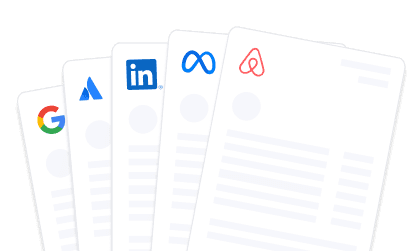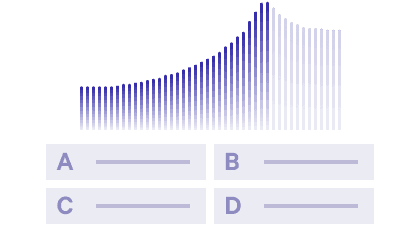AI Product Manager Interviews: Questions & Tips
Prepare for AI product manager interview questions with examples and tips that show your impact, technical fluency, and product sense.
Posted September 8, 2025

Join a free event
Learn from top coaches and industry experts in live, interactive sessions you can join for free.
Table of Contents
Landing an AI product manager interview means stepping into a realm where product strategy, technical fluency, and ethical considerations collide. Unlike a typical product manager role, AI PMs must decode complex Artificial Intelligence systems, translate technical feasibility into business value, and navigate bias, fairness, and data quality, all while aligning with cross-functional teams that span engineering, data scientists, and go-to-market stakeholders.
In this guide, I’ll help you move beyond memorized interview responses. You’ll learn tactical frameworks, expert-level breakdowns, and annotated answers that not only anticipate questions like “How do you balance technical feasibility with user needs in AI product development?” but also spotlight how to leverage data, steer AI technologies, and bridge complex AI concepts with clarity and conviction.
Read: What is Product Management?
What Makes an AI Product Manager Interview Different?
AI product manager interviews are uniquely rigorous because they test your ability to operate at the intersection of machine learning, product strategy, and ethics, all while communicating clearly across deeply technical and non-technical teams.
Unlike traditional PM interviews, AI PMs are evaluated on three key dimensions:
- Technical Fluency – Can you explain machine learning algorithms, evaluate model performance, and guide teams on data quality, bias mitigation, and technical feasibility? You don’t need to code, but you do need a working fluency in AI system design, training workflows, and deployment implications.
- Product and Business Intuition – Can you tie AI capabilities to real-world user needs and business goals? Interviewers want to see that you can balance innovation vs ROI, choose the right AI features to build, and articulate the tangible benefits of AI to users and stakeholders.
- Cross-Functional Leadership – Great AI PMs act as translators between data scientists, engineers, and business stakeholders. In interviews, you’ll often be tested on how you navigate conflicting priorities, lead cross-functional teams, and ensure that everyone, from marketing to infrastructure, understands the “why” behind the AI product.
Ultimately, AI PM interviews are designed to test whether you can turn complex AI concepts into valuable, usable products, and whether you can do so responsibly, with a clear lens on ethical considerations, user impact, and evolving AI trends.
Core AI Product Manager Interview Question Categories
AI product manager interviews tend to fall into four major buckets, each designed to assess a different part of your thinking, technical fluency, and leadership style. Below is a breakdown of each category, the types of questions you’ll face, and what strong answers need to demonstrate.
| Category | Example Questions | What’s Being Tested |
|---|---|---|
| Technical / AI Knowledge | “Explain supervised vs unsupervised learning.”; “How do you handle bias in training data?” | Your grasp of AI technologies, model performance, and data quality |
| Product Strategy | “How do you prioritize AI initiatives?”; “How would you evaluate whether to add an AI feature?” | Vision, ROI thinking, and AI product development strategy |
| Execution / Delivery | “How do you balance technical feasibility with user needs?”; “GTM for an AI feature?” | Roadmapping, trade-off management, and model performance |
| Behavioral / Cross-functional | “Tell me about aligning data scientists and engineers”; “Resolving stakeholder conflicts” | Leadership, cross-functional teams, and communication |
Technical & AI-Focused Questions
“Explain supervised vs unsupervised learning to a non-technical stakeholder.”
How to approach it:
Start with an analogy (e.g., “supervised learning is like studying with an answer key, unsupervised is like organizing a junk drawer without one”). Then clearly define each: supervised learning involves labeled data and is used for classification/regression; unsupervised learning finds patterns or groupings without labels. Share relevant business use cases like spam detection (supervised) or customer segmentation (unsupervised). Close with a comment on model performance trade-offs, such as precision vs interpretability.
What great answers show:
You can simplify complex AI concepts, speak fluently with both technical and non-technical audiences, and connect ML fundamentals to business outcomes.
“How do you handle bias in training data?”
How to approach it:
Start by naming common sources of bias (historical, sampling, labeling). Walk through your bias mitigation process: audit datasets for representativeness, test performance across subgroups, use techniques like data augmentation or reweighting, and continuously monitor post-deployment. Mention tools or practices (e.g., fairness dashboards, demographic parity metrics) and how they fit into your AI product development process.
What great answers show:
You’re ethically responsible, aware of how bias manifests in real-world AI systems, and proactive in operationalizing fairness. You understand both the technical and reputational risks of biased AI.
“What metrics matter when evaluating an AI product?”
How to approach it:
Include a mix of traditional product metrics (user engagement, user feedback, retention, conversion) and AI-specific KPIs like model accuracy, recall, precision, latency, and model performance over time. Emphasize contextual trade-offs. For instance, why precision matters more than recall in medical diagnostics. Discuss how you ensure metrics align with user expectations and business goals, and how they evolve from prototype to production.
What great answers show:
You evaluate success holistically, balancing algorithmic performance with user and business impact. You can intelligently defend metric choices and iterate based on results.
Product Strategy and Business Impact Questions
“How would you evaluate whether to add an AI feature to an existing product?”
How to approach it:
Start with a user needs assessment: what pain point would AI solve, and is AI the best solution? Next, evaluate technical feasibility (model availability, data readiness, latency constraints), followed by business impact (ROI, KPIs, time-to-value). Prototype quickly, validate with real users, and A/B test against baseline solutions. Don’t forget to evaluate the computational load and ongoing maintenance costs of the AI component.
What great answers show:
You don't chase shiny objects. You’re strategic, disciplined, and customer-first. You know how to pressure test AI ideas against product and engineering realities.
“What’s your framework for prioritizing AI initiatives?”
How to approach it:
Use a structured prioritization model like RICE or ICE, but adapt it for AI. Score based on user reach, potential business impact (retention, revenue, efficiency), confidence (based on data quality and model maturity), and effort (engineering time, data acquisition, infrastructure needs). Mention how you incorporate ethical considerations and evaluate technical feasibility before committing resources.
What great answers show:
You have a repeatable, data-informed process that balances speed, ROI, and risk. You prioritize with intention, not intuition.
“How do you balance innovation with ROI?”
How to approach it:
Frame your answer with the explore-exploit balance. You might allocate 70% of your roadmap to scalable, validated features and 30% to experimental AI initiatives. Use the Build-Measure-Learn loop to test new AI capabilities quickly and cheaply. Share an example of an AI feature you sunset or pivoted when ROI didn’t materialize.
What great answers show:
You know how to manage AI projects with a portfolio mindset, using data and feedback to continuously adjust. You treat innovation as a hypothesis to validate, not a guaranteed success.
Behavioral & Cross‑Functional Questions
“Tell me about a time you aligned data scientists and engineers on priorities.”
How to approach it:
Use the STAR framework. Set up a situation where priorities were unclear or teams were misaligned (e.g., DS optimizing for accuracy while ENG wanted faster inference). Share how you created a shared roadmap, clarified trade-offs (model performance vs latency), and facilitated open discussion. End with the impact: faster release, better results, or improved team morale.
What great answers show:
You lead through alignment, not authority. You understand how cross-functional teams think differently, and you build bridges, not bottlenecks.
“Describe a conflict with a stakeholder and how you resolved it.”
How to approach it:
Pick a story where the stakes were high and the resolution required both empathy and data. Maybe a marketing leader pushed for a new AI feature without user validation. Show how you listened, reframed the conversation around business goals, brought in user research or metrics, and co-created a better solution. Bonus points if you used data storytelling or visual artifacts to shift their perspective.
What great answers show:
You manage conflict without creating friction. You’re collaborative, analytical, and focused on long-term impact, not short-term wins.
Sample AI PM Interview Questions with Answers
These annotated example answers go beyond surface-level responses—they show how top candidates use structure, clarity, and impact metrics to convey depth, leadership, and technical fluency. Each is modeled after real interview expectations at companies like OpenAI, Meta, and Google.
1. Technical Simplification
Question: “How does an ML model train?”
Answer (Annotated):
Situation: I was working on an early-stage AI chatbot for a customer support platform. The challenge was getting the team—especially design and marketing—aligned on how the model worked so we could better scope expectations.
Simplified Explanation (for non-technical stakeholders): “Think of it like teaching by example. We feed the model thousands of past support conversations, each labeled with the correct resolution. The model finds patterns in the data, then adjusts its internal weights—basically its ‘rules’—until it can predict the right responses to new messages on its own.”
Impact Metric: After several training iterations, the model’s resolution rate improved from 62% to 81%, which led to a 25% drop in live agent escalations.
Why This Works: It uses analogy, keeps jargon minimal, and clearly links the technical process to business value and user outcomes. This is exactly what interviewers are looking for: clarity, technical fluency, and product impact awareness.
2. Strategy & Metrics
Question: “How would you measure the success of an AI-powered search feature?”
Answer (with expert framing):
Context: Let’s say we’re adding semantic search to a content discovery platform using an embedding-based model.
Core Metrics:
- User engagement: Click-through rate (CTR) on search results, time to find relevant content
- Accuracy and relevance: Precision@k and recall@k for internal evaluation
- User satisfaction: Net Promoter Score (NPS), satisfaction surveys post-query
- Behavioral lift: Reduction in repeated queries or refinements (key performance indicators of higher success on first try)
Measurement Approach: I’d start with a baseline using the current keyword search, then run A/B tests with the AI model to measure relative lift. I’d also segment by user type (e.g., power users vs. first-timers) to detect group-level impacts. Lastly, I’d monitor model performance drift over time as user behavior evolves.
Why This Works: It balances product metrics, user research, and technical evaluation—all through a real-world lens. It shows you understand that AI feature success requires both algorithmic quality and business/user alignment.
3. Behavioral & Judgment Under Uncertainty
Question: “Tell me about a time you had to make a decision with incomplete data.”
Answer (STAR format):
Situation: At my last company, we launched a beta for an AI-powered recommendation engine, but the demographic data was incomplete due to GDPR compliance constraints.
Task: We had to decide whether to roll out the feature broadly, but without full visibility into how it performed across key user segments.
Action: I worked with the data science team to define proxy metrics (e.g., click-through and session length) by region and device type. We also interviewed a sample of beta users to supplement gaps with qualitative feedback. Based on this triangulation, we identified no major performance disparities and chose to move forward—while adding instrumentation for post-launch monitoring.
Result: The full rollout drove a 15% increase in user engagement, and a follow-up audit confirmed consistent performance across cohorts. We also learned how to better design future experiments with compliance constraints in mind.
Why This Works: It shows pragmatic decision-making, analytical creativity, and the ability to act with confidence despite ambiguity—exactly what interviewers want in AI PMs dealing with real-world constraints.
Read: The 50 Most Common Product Manager Interview Questions (With Sample Answers)
How to Prepare and Stand Out in an AI PM Interview
Succeeding in an AI product manager interview requires more than just technical literacy—it demands strategic clarity, ethical awareness, and storytelling that resonates across engineering, data, and business. Here's how to prepare like a top 1% candidate.
Master the Right Level of Technical Fluency
You don’t need to be a machine learning engineer, but you do need to confidently speak the language. Focus on understanding core AI/ML concepts like regression, classification, supervised vs unsupervised learning, model training pipelines, and the fundamentals of how AI systems are deployed in real-world products.
What differentiates great AI PMs is their ability to evaluate technical feasibility, ask the right questions about model performance, and understand how decisions around data quality or algorithm choice impact the end user. You should also be familiar with ethical issues like data anonymization, fairness, and explainability, topics that are increasingly central to hiring conversations.
Stay Sharp on AI Trends and Emerging Technologies
Hiring managers expect AI PMs to be intellectually curious and contextually aware. You should be able to speak fluently about:
- Generative AI and LLMs (e.g., ChatGPT, Claude, Gemini)
- Bias mitigation techniques and responsible AI practices
- AI capabilities and limitations in product environments
- Market trends around personalization, automation, or AI-powered search
Follow leading researchers and PMs on LinkedIn, subscribe to AI product newsletters (like Gradient Flow or Chip Huyen's), and be ready to reference recent examples or case studies from companies like OpenAI, Meta, or Perplexity.
Practice Translating Technical Concepts into Business Impact
A common reason candidates fail interviews is that they can’t explain technical trade-offs to non-technical stakeholders, or they lose clarity when trying.
Practice breaking down AI concepts into everyday analogies or metaphors. For example: “Think of model training like preparing for a multiple-choice test using a study guide—it gets better the more questions it sees.” Or: “An embedding model is like turning words into GPS coordinates, so you can measure how close in meaning they are.”
Top candidates don't just simplify, they connect the dots between technical decisions, product strategy, and user experience.
Prepare Leadership Stories That Cross Technical and Business Lines
AI product management is inherently cross-functional. You’ll need stories that showcase how you’ve:
- Aligned data scientists and engineers with business priorities
- Navigated ambiguity in AI product development
- Managed cross-functional dependencies and stakeholder conflict
- Led with data, but kept user needs front and center
Use the STAR framework, but focus especially on the translation moments, where you helped two teams with totally different mental models get on the same page.
Use the Right Prep Resources (And Filter the Noise)
Don’t just Google “PM interview prep.” Instead, tap into resources built specifically for AI PMs:
- Chip Huyen’s Designing Machine Learning Systems – the gold standard for PMs working with ML teams
- Reddit’s r/ProductManagement – especially threads on technical PM and FAANG interviews
- AI-focused coaching platforms (like Leland!) – where you can practice with real PMs who’ve worked on AI products at Meta, Google, and OpenAI
The best prep combines structured frameworks with mock interviews, feedback loops, and tailored coaching that reflects your specific background.
Don’t Underestimate the Interview Tech Stack
Here's a detail most candidates miss: some companies now use AI-powered tools to screen interview recordings. These systems assess everything from eye contact and tone to response structure. One candidate, interviewed by an AI bot, shared that he was screened out for wearing a hoodie and lacking facial engagement, despite strong answers.
This doesn’t mean you should over-polish, but it does mean you should be mindful of:
- Camera setup and lighting
- Eye contact with the camera (not just the screen)
- Speaking clearly and concisely
- Dressing for the company’s culture, even in virtual settings
Think of it as part of the product: you're communicating clarity and confidence under real-world constraints.
Read: Tips from an Expert: How to Prepare for Your Product Management Interview
Your Next Step Toward Landing the AI PM Role
Breaking into AI product management or leveling up into a top-tier role requires more than just knowing the answers. You need to demonstrate clear thinking, technical fluency, and strategic insight in every interaction. Interviews are not just about what you say, but how convincingly you communicate your decision-making, your leadership, and your understanding of AI’s real-world impact.
If you're serious about standing out, don’t just prepare, practice with purpose.
Top AI PM coaches have built products at companies like Google, OpenAI, Meta, and Amazon. They’ll help you refine your story, run realistic mock interviews, and pressure-test your responses using AI-specific frameworks that hiring teams actually use.
Book a 1:1 session with an AI PM coach to move from good to exceptional and turn your preparation into a competitive advantage. Explore product management coaches here. Also, check out free events to unlock your full PM potential!
Read these next:
- Product Sense Interview: What It Is, Questions, & Tips
- Product Design Interview: What It Is, Questions, & Tips
- Product Marketing Manager (PMM) Interview Questions & Tips
- Data Product Manager Interviews: Questions & Tips
- Product Manager Case Study Interviews: What to Expect, Questions, & Examples
- 20 Common System Design Interview Questions (With Sample Answers)
FAQs
What technical knowledge should an AI product manager have for interviews?
- You’ll need a solid grasp of AI technologies, including machine learning, model training, data analytics, model performance, and an understanding of technical feasibility.
Why does ethical AI matter in product manager interviews?
- Hiring teams want confidence that you can spot bias, ensure data quality, fairness, and design AI solutions responsibly.
What are common mistakes candidates make in AI PM interviews?
- Overloading with jargon, ignoring ethics, treating AI features as magic instead of grounded in data and ROI, or failing to articulate cross-functional collaboration stories.
What smart questions should I ask at the end of an AI product manager interview?
- Examples: “How do you measure success for AI features here?”, “What frameworks guide your decisions around AI product development?”, or “How do engineering, data scientists, and PMs align on complex AI concepts?”
Browse hundreds of expert coaches
Leland coaches have helped thousands of people achieve their goals. A dedicated mentor can make all the difference.


























